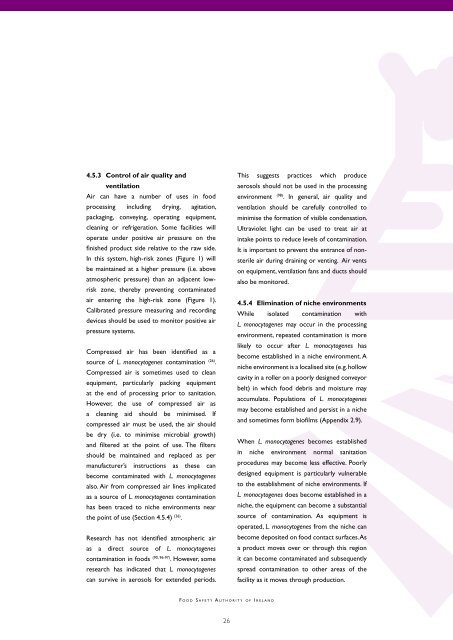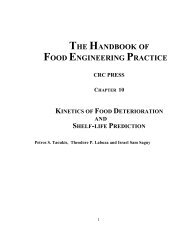4.5.3 Control of air quality andventilationAir can have a number of uses in foodprocessing including drying, agitation,packaging, conveying, operating equipment,cleaning or refrigeration. Some facilities willoperate under positive air pressure on thefinished product side relative to the raw side.In this system, high-risk zones (Figure 1) willbe maintained at a higher pressure (i.e. aboveatmospheric pressure) than an adjacent lowriskzone, thereby preventing contaminatedair entering the high-risk zone (Figure 1).Calibrated pressure measuring and recordingdevices should be used to monitor positive airpressure systems.Compressed air has been identified as asource of L. monocytogenes contamination (26) .Compressed air is sometimes used to cleanequipment, particularly packing equipmentat the end of processing prior to sanitation.However, the use of compressed air asa cleaning aid should be minimised. Ifcompressed air must be used, the air shouldbe dry (i.e. to minimise microbial growth)and filtered at the point of use. The filtersshould be maintained and replaced as permanufacturer’s instructions as these canbecome contaminated with L. monocytogenesalso. Air from compressed air lines implicatedas a source of L. monocytogenes contaminationhas been traced to niche environments nearthe point of use (Section 4.5.4) (26) .Research has not identified atmospheric airas a direct source of L. monocytogenescontamination in foods (90, 96-97) . However, someresearch has indicated that L. monocytogenescan survive in aerosols for extended periods.This suggests practices which produceaerosols should not be used in the processingenvironment (98) . In general, air quality andventilation should be carefully controlled tominimise the formation of visible condensation.Ultraviolet light can be used to treat air atintake points to reduce levels of contamination.It is important to prevent the entrance of nonsterileair during draining or venting. Air ventson equipment, ventilation fans and ducts shouldalso be monitored.4.5.4 Elimination of niche environmentsWhile isolated contamination withL. monocytogenes may occur in the processingenvironment, repeated contamination is morelikely to occur after L. monocytogenes hasbecome established in a niche environment. Aniche environment is a localised site (e.g. hollowcavity in a roller on a poorly designed conveyorbelt) in which food debris and moisture mayaccumulate. Populations of L. monocytogenesmay become established and persist in a nicheand sometimes form biofilms (Appendix 2.9).When L. monocytogenes becomes establishedin niche environment normal sanitationprocedures may become less effective. Poorlydesigned equipment is particularly vulnerableto the establishment of niche environments. IfL. monocytogenes does become established in aniche, the equipment can become a substantialsource of contamination. As equipment isoperated, L. monocytogenes from the niche canbecome deposited on food contact surfaces. Asa product moves over or through this regionit can become contaminated and subsequentlyspread contamination to other areas of thefacility as it moves through production.F O O D S A F E T Y A U T H O R I T Y O F I R E L A N D26
Table 6 illustrates some identified niche environments associated with food processing facilities. Manyof these are associated with equipment design or operational failure (11, 26) . The risk of contaminationcan be reduced by identifying the niche environment (i.e. source of L. monocytogenes contamination),revising the sanitation procedures and improving the sanitary design of equipment. It is important tonote that the costs associated with identifying and eliminating a niche are offset by the potential costsassociated with a product recall or outbreak of foodborne illness related to contamination of a product.Table 6. Potential Niche EnvironmentsAreaAncillary ItemsAncillary ServicesPersonnel HygienePlant HygienePremisesEquipmentExampleRubbish Bins, SkipsCompressed Air Lines, Hollow Bump Guards on Bottoms of Doors,Plexiglas ShieldsWash Basins, Aprons, GlovesCleaning EquipmentCracked Walls, Floors, Ceilings, Wet Insulation, Standing Water, SwitchesHollow Rollers on Conveyors, Conveyor Belts, Slicers, Dicers, Mincers,Weighing Scales, Switches, Rubber Seals, Open Bearings, EquipmentMotor Housings, Hollow Frames, Ice Makers, Damaged Pipe/Hoses,Hollow Box Cutters, Brine Injection Equipment, Packaging EquipmentHand Tools, Hoppers, Valves4.5.5 Curing, brine injection and marinationCuring (i.e. direct immersion in a curing solution and/or dry rubbing with salt), brine injection (i.e.using brine solutions and needle injection equipment) and marination (i.e. direct application of marinadepastes or solutions by hand, mechanical tumblers etc.) commonly used with meat, fish and somedairy products (Appendix 1.9 - 1.13) are at high risk from L. monocytogenes contamination. Whenusing these techniques the following will minimise risks of contamination (81) :1. All equipment should be adequately cleaned and sanitised before use. Particular attention shouldbe given to needle injection equipment and mechanical tumblers2. Brine solutions should be covered and refrigerated (≤ 3 o C) until use3. Where curing or marination is taking place, the room/area or equipment (e.g. temperaturecontrolled mechanical tumbler) should be temperature controlled (≤ 5 o C), ideally ≤ 3 o C4. Where brine injection is taking place, the room/area should be temperature controlled(≤ 12 o C) using brine solutions at ≤ 3 o C5. Unused and used cure, injection and marination solutions should not be stored for further use6. Overflow brine solutions produced during injection procedures should be discardedF O O D S A F E T Y A U T H O R I T Y O F I R E L A N D27
- Page 5 and 6: 7. Public Health and Regulatory Aut
- Page 7 and 8: 1. INTRODUCTION1.1 BackgroundLister
- Page 10 and 11: This clinical entity has been recog
- Page 14 and 15: 2. FACTORS AFFECTING SURVIVAL ANDGR
- Page 16 and 17: 2.4 Control of L. monocytogenesWhil
- Page 18 and 19: 3.2 Standard Operating ProceduresSt
- Page 20 and 21: from doors and windows. For similar
- Page 22 and 23: 12. Areas where processed product i
- Page 24 and 25: 3.9 MaintenanceWhile routine mainte
- Page 26 and 27: All external bins should be sited i
- Page 28 and 29: 4. L. MONOCYTOGENES CONTROL IN FOOD
- Page 30 and 31: Control of L. monocytogenes should
- Page 34 and 35: 7. If marinades are to be used for
- Page 36: circumstances, the frequency and ex
- Page 40 and 41: 4.10 SummaryListeria monocytogenes
- Page 42 and 43: 5. SPECIFIC FOOD SECTOR ISSUES5.1 I
- Page 44 and 45: The use, maintenance and sanitation
- Page 46 and 47: Fresh produce processors should con
- Page 48 and 49: 6. CATERING/RETAIL/CONSUMERS: SPECI
- Page 50 and 51: 6.4 Recommendations6.4.1 Caterers a
- Page 52 and 53: 6. Associated food recalls led to l
- Page 54 and 55: 7.2.4 Control measuresThe outbreak
- Page 56 and 57: 7.4 RecommendationsRelevant agencie
- Page 58 and 59: 11. A product recall and traceabili
- Page 60 and 61: APPENDIX 1. GROWTH, SURVIVAL AND CO
- Page 62 and 63: 1.6 Modified Atmosphere PackagingMo
- Page 64 and 65: of 20 o C to 50 o C while hot smoki
- Page 66 and 67: APPENDIX 2. SANITATION2.1 Introduct
- Page 68 and 69: 2.2 SanitationEmployees involved in
- Page 70 and 71: processing industry and L. monocyto
- Page 72 and 73: Application of powdered/crystalline
- Page 74 and 75: APPENDIX 3. EXAMPLE PROCEDURES FOR
- Page 76 and 77: Table 9. Suggested Environmental Sa
- Page 78 and 79: 4.5 High-Risk Area (Zone 4)This wil
- Page 80 and 81: APPENDIX 6. MICROBIOLOGICAL CRITERI
- Page 82 and 83:
BIBLIOGRAPHY*1. United States Food
- Page 84 and 85:
19. Food Agriculture Organisation a
- Page 86 and 87:
40. Food Safety Authority of Irelan
- Page 88 and 89:
62. Rayner, J., veeh, R. and Flood,
- Page 90 and 91:
83. European Commission (2004) Guid
- Page 92 and 93:
102. Jay, J.M. (1992) Indicators of
- Page 94 and 95:
122. Castillo, A and Rodriguez-Garc
- Page 96 and 97:
143. El-Kest, S.E., Yousef, A.E. an
- Page 98 and 99:
164. Aase, B., Sundheim, G., Langsr
- Page 100:
MEMBERS OF THE MICROBIOLOGY SUB-COM














